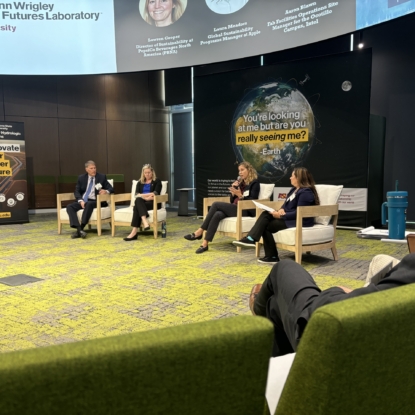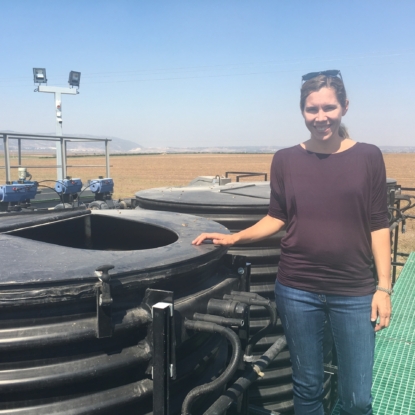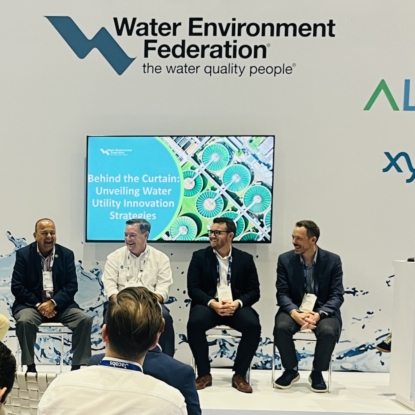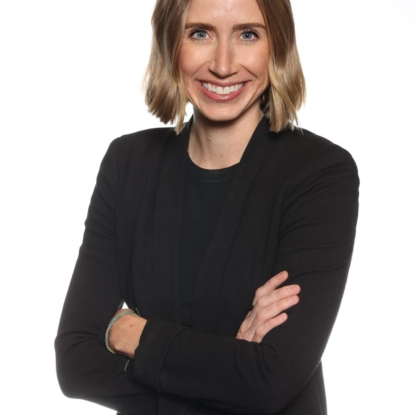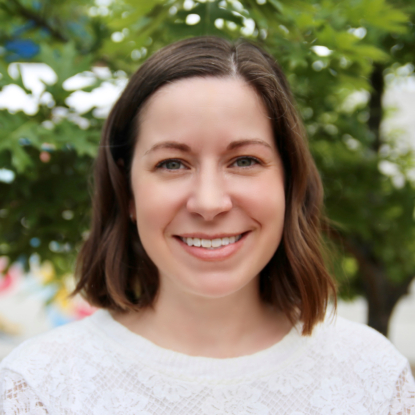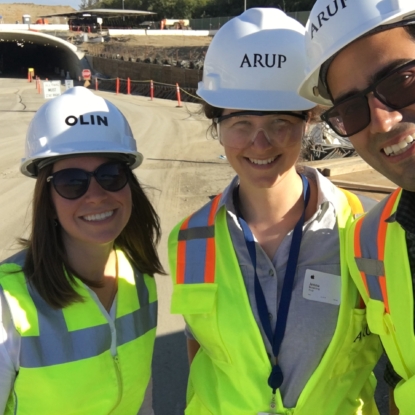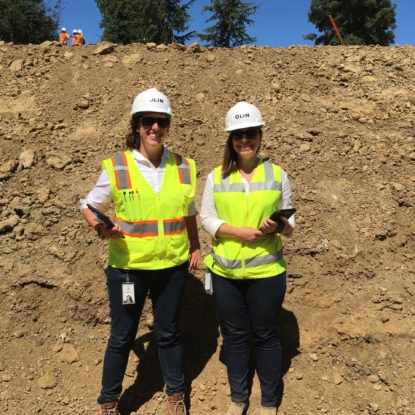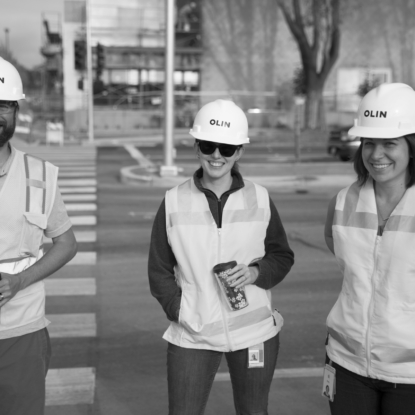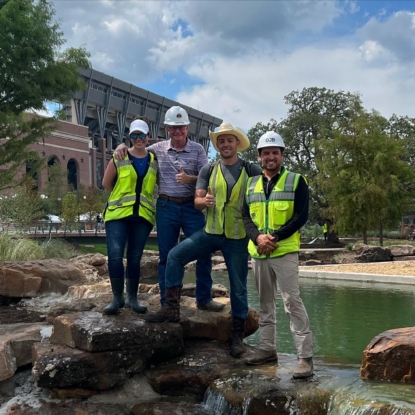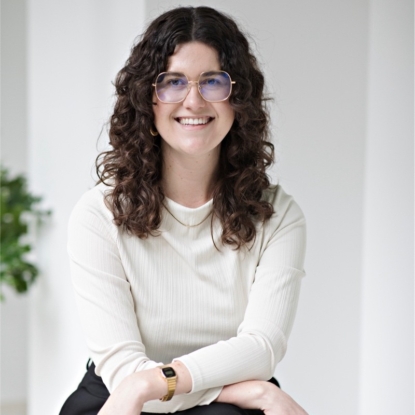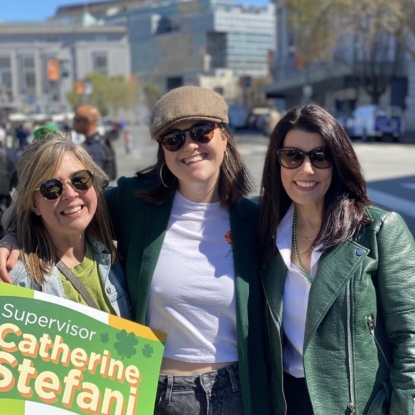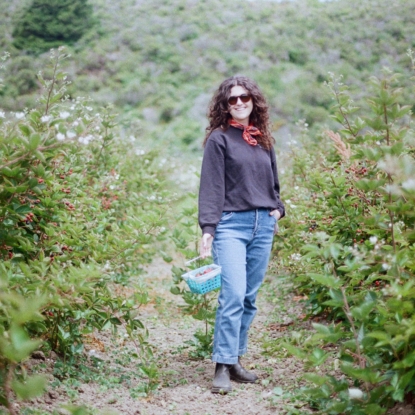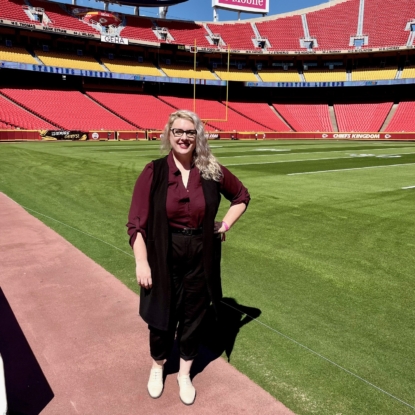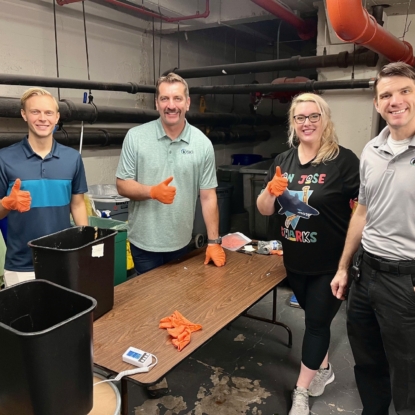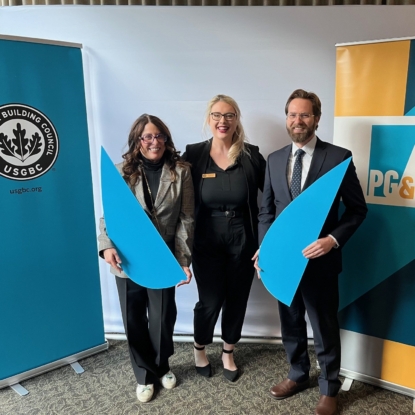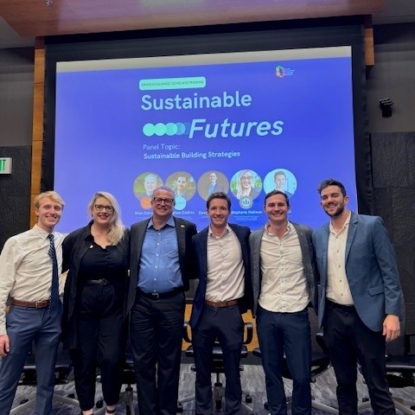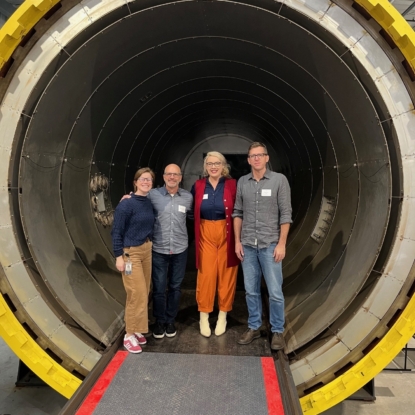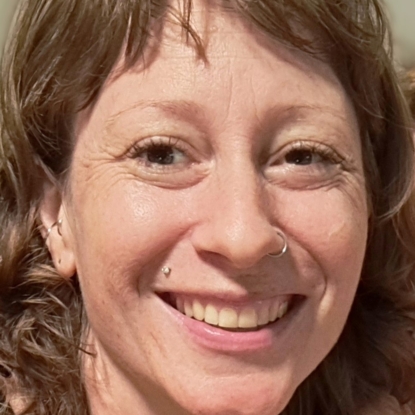Leading Women in Sustainability

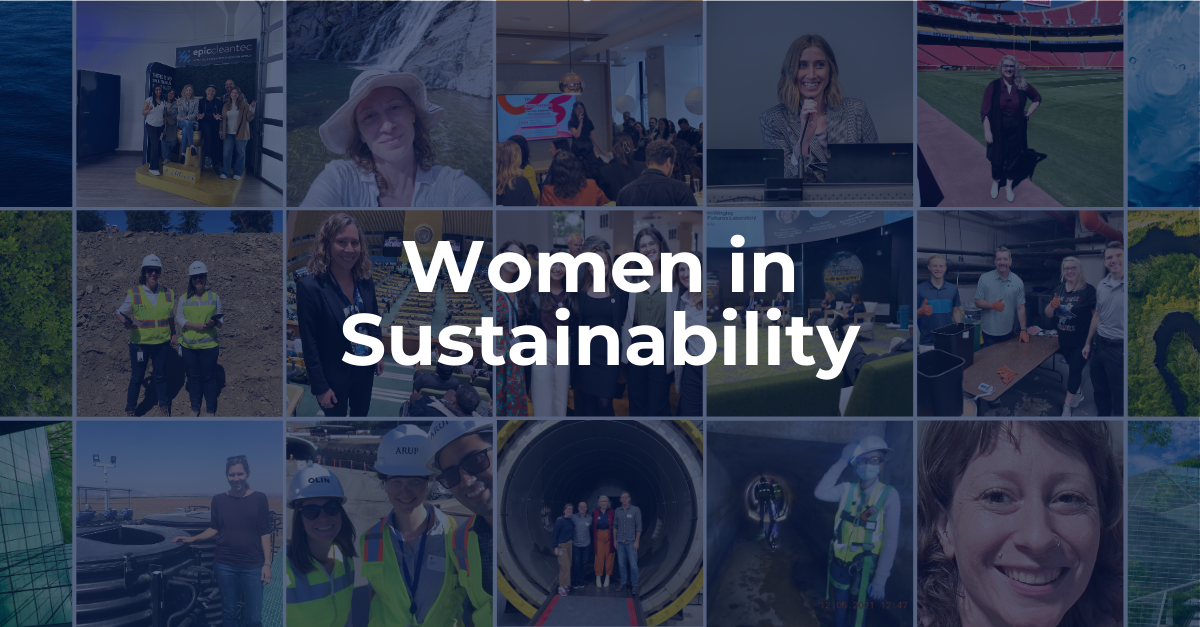
Women have long been at the forefront of sustainability, pioneering innovative solutions and driving meaningful change across industries. Their leadership, expertise, and commitment to environmental stewardship have shaped the way we approach resource conservation, climate resilience, and circular solutions.
This year, we’re spotlighting women leaders who are transforming sustainability in their respective fields, from regenerative design and green building to waste reduction and climate policy.
These changemakers exemplify the power of leadership, innovation, and advocacy in creating a more sustainable future. By sharing their stories, we hope to inspire the next generation of female leaders and reinforce the importance of diverse voices in shaping a more resilient world.
Laura Meadors, Global Energy & Sustainability at Apple
Laura Meadors is Apple’s Global Sustainability Programs Manager. She leads water, zero waste, and embodied carbon activities across the company’s facilities portfolio. She joined Apple in 2014 and previously managed renewable energy procurement and environmental reporting. Laura began her career on Wall Street trading agricultural commodities and has spent the last twenty years working in energy, water, and carbon markets. She holds a master’s degree in natural resource economics from the Yale School of the Environment and a bachelor’s degree in political science from Wellesley College.
Q: As a woman in your industry, what challenges have you faced, and what strategies have helped you overcome them?
A: Well, one of the unexpected benefits of going to a women’s college, running on a women’s racing team, and being involved in things like the Association for Women in Water, Energy & the Environment (AWWEE) is that I often don’t really notice I’m the only women in the room until it’s pointed out to me. In my first job out of grad school, I was the first woman on the trading floor at the hedge fund I joined. I didn’t know any differently, but I was told later by a colleague that there had been a meeting to announce a woman was joining the floor and to tone down the raucousness. I can’t imagine what it must have been like before! But it was a fun and challenging environment — I never felt uncomfortable, and I felt I was taken seriously.
There have been exceptions, though. A couple of times, in different roles at different companies, I found myself in a large meeting of 20 people, going around doing introductions, and I got skipped over. In the moment, you’re wondering — is this really what’s happening? Are they ignoring me, thinking I’m the note-taker? Or am I overthinking it, and they are just about to come back to me? The first time it happened, I was a junior, and someone else eventually came to my aid and pointed out that I’d been skipped. The second time, I was more experienced, and I knew what was happening — I swiftly corrected it myself. I’ve learned to go head-on at issues like that — if you have to stop and think about it, it’s probably exactly what it looks like. So I try to establish myself in new situations early and decisively. Take up space, speak up, and always, sit at the table.
Q: Can you share a pivotal moment in your career or a project that you are particularly proud of? How has your work contributed to advancing sustainability in your field?
A: Like a lot of people with somewhat ambiguous career paths, I have generally had very little business being in whatever role I’m in. I remember once, fairly early on at the British Consulate as a trade and investment officer, I was given the job of producing and leading a trade mission on wave and tidal energy. I had no idea what a trade mission was, nor how to organize the logistics of transporting 30 people down the West Coast over multiple days, or how to coordinate meetings with the right regulatory, business and R&D connections that would prove relevant to the attendees. But I did know something about renewable energy technologies, so I started with that, and piece by piece, I managed to put together what turned out to be an award-winning event. That gave me the confidence to know that I can generally figure out what needs to be done, even when I don’t really have the background or experience.
That turned out to be very useful in my career, because most of my roles have been about inventing something that didn’t exist before — new businesses, new programs, new strategies. For example, it has been an incredibly fulfilling experience to launch new programs and build out teams in water and circular economy at Apple, having started from basically just me and some ideas nearly nine years ago. All of the work I do in sustainability is grounded in delivering quantifiable value, through models that are accessible and replicable.
Q: How has education—whether through mentorship, advocacy, or outreach (as a mentor or mentee) shaped your journey?
A: I’m fortunate to have had my career come full circle in the last few years, back to working on what I studied in grad school — water markets and resource economics. People often look at my background and think it’s either fascinating or really random: I’ve worked at a hedge fund, a brokerage, a non-profit, and in government, all before coming to the corporate sector. But I’ve always had a north star — delivering environmental benefits through innovative market-based tools. I’ve watched and learned from some extraordinary managers along the way – ones that had vision and inspired me, and others who taught me how to plan, organize and present ideas. I can’t say I’ve had a singular mentor, but I have fostered sincere relationships with people I admire, and I maintain those relationships actively, so I have a strong network to lean on. One of the things I’m proudest of is that throughout my different roles, I’ve been able to keep working with people I met earlier in my career and respect deeply.
I’ve also become a mentor myself now, and have really enjoyed helping others on their journeys. There’s something about helping others clarify their path that helps you see yours more clearly as well. And, I think to be successful in this industry, with all of its ups and downs, you have to have genuine curiosity. Always be learning, and invest in your own ongoing education, through industry publications, courses, or even just networking events.
Q: If you could go back and give advice to yourself at the start of your career, what would it be?
A: Earlier in my career, I would get stymied by whether the decision I was making about a role was the right decision or not, and what all the implications might be going forward. Was I on the right path? Now, I’d tell myself to worry less. Just move forward; you’ll make mistakes and your career path is a zig-zig; there’s always an opportunity to course-correct.
Basically the first decade of your career is really just a series of internships anyway; you’re figuring out what your strengths and weaknesses are, and what you want to spend your days doing. The other thing I’d say is — good job on figuring out some technical skills and an subject matter expertise early on! At the start of grad school, my advisor told us not to approach it like a kid in a candy store — to make sure we came out of school with an expertise and a focus, and it was great advice. I have had points in my career where I wondered if I missed the boat by not developing a specific occupation — say, financial analyst or geohydrologist — but I’ve found success at places that value intellectual agility, some technical skills and subject matter expertise. Vague, ambiguous environments are where I thrive.
Q: What’s something about you—whether a passion, hobby, or life experience—that might surprise people?
A: Well, my usual answer to this is that I spent six months living at (not in!) Biosphere 2 in Arizona in college, and that shaped my interest in this field and my career trajectory. Other than that, I’ve been a competitive runner since I was 11, and still manage to race, though a lot less competitively now. And post-pandemic, I decided it might be nice to have a hobby, so I picked up learning the violin, which it turns out is a lot harder than it looks! But it’s fun to have a completely different kind of challenge to work on.
Sonora Hill, Senior Portfolio Innovation Manager at Imagine H2O
Sonora Hill leads Imagine H2O’s global portfolio program, consisting of 220+ water startups that have raised >$1B in early stage capital since 2009. She supports startup development, impact tracking and partner management to drive adoption of emerging solutions in the water sector. Prior to Imagine H2O, Sonora designed capital improvement projects at the San Diego County Water Authority and supported commissioning of an industrial wastewater facility at Antero Resources. Sonora holds a M.S. in Engineering and Technology Management and B.S. in Chemical Engineering from Colorado School of Mines.
Q: As a woman in your industry, what challenges have you faced, and what strategies have helped you overcome them?
A: I went to a small powerhouse engineering school that was 80% male, so I am no stranger to the challenge of operating in a male-dominated industry. As I’ve learned from the entrepreneurs I work with, turn whatever challenges you may face into opportunities.
- Opportunity #1: Diversity drives innovation. Having diverse perspectives is critical to creating new ways to solve problems. Many times, I have been the only female in a room that I have capitalized on to create a platform to stand on. Being different is a good thing.
- Opportunity #2: Effective communication is key. Honing in on my ability to convey my unique perspective confidently has been key to my development as a professional and a leader. Clear communication and storytelling is an art that pays dividends in any industry.
- Opportunity #3: Lean into constructive conflict. Rather than shying away from difficult conversations, I’ve learned to approach them as opportunities for growth and influence. By confidently articulating my viewpoints and navigating differing opinions, I’ve strengthened my ability to lead and drive positive outcomes.
Q: Can you share a pivotal moment in your career or a project that you are particularly proud of? How has your work contributed to advancing sustainability in your field?
A: My time as a design engineer at the San Diego County Water Authority was pivotal in my career as it wasn’t just a job: it was a front-row seat to the realities of the water crisis. Working at a utility at the epicenter of the water crisis in Southern California uncovered that the status quo is no longer an option and innovation is the key to solving the world’s water problems. These experiences led me to my current role as Director, Programs and Partnerships at Imagine H2O, a global non-profit accelerator program on a mission to solve the world’s water crisis through innovation and emerging technologies.
Since 2022, I built out the portfolio program that supports over 200 water startups globally as they scale their business in water. Through this program, we’ve effectively bridged the gap between cutting-edge technology and real-world implementation by connecting startups with investors and end-users. This has ultimately resulted in more capital coming into the water sector and more customers deploying novel technologies. At a time when climate change is exacerbating our water resources, adoption of emerging technologies is essential for a resilient and water-secure future.
Q: How has education—whether through mentorship, advocacy, or outreach (as a mentor or mentee) shaped your journey?
A: I might be biased, but the water sector is chock full of really, really good people all tracking forward toward a more sustainable water future. I am indebted to the people that have taken the time to share their wealth of knowledge with me. Colette Van Straaten is one of the original bada** women paving the way for sustainably managing produced water in the energy sector, one of the most overlooked challenges in wastewater. After almost a decade of knowing her, there are still days when I ask myself, “What would Colette do?” Kelly Trott is a legend in the world of water innovation, and has not only helped me define what my impact in water will be, but has been the biggest catalyst for my growth in water innovation. She is a one in a million resource.
The best part of my job is learning from the entrepreneurs I work with everyday, who are some of the most intelligent, humble, and kind go-getters you’ll come across. If you don’t know these people, run, don’t walk toward the opportunity to learn from them.
- Orianna Bretschger, Co-founder and CEO of Aquacycl, who is the definition of a founder that walks the talk.
- Paige Peters, Founder and CTO of Rapid Radicals, who taught me to optimize processes by literally stepping into the perspective of a water molecule – the epitome of a truly visionary water leader.
- Louise Parlons Bentata, Co-founder and CEO of Bluemethane, who is paving the path for founders tackling the water energy nexus, one of the most critical challenges for both climate change mitigation and adaptation.
Q: If you could go back and give advice to yourself at the start of your career, what would it be?
A: Trust, and then verify, your gut.
Q: What’s something about you—whether a passion, hobby, or life experience—that might surprise people?
A: Some might be surprised to find me in improv classes in NYC, but honestly, it’s been the most unexpected, yet impactful, training I’ve done in a while. It’s taught me the power of collaborative storytelling, the importance of fostering an inclusive space for creative ideas, and how to turn ‘what if’ into ‘let’s do it.’ Plus, there’s nothing more fun than being surprised by your own sense of humor.
Katy Martin, Principal at OJB Landscape Architecture
Katy Martin earned a Master of Landscape Architecture from the University of Pennsylvania, a Master of Architecture from Texas Tech University, and a Bachelor of Science in Architecture from Texas Tech University. As a Principal in the Dallas office of OJB Landscape Architect, Katy has cultivated a passion for solving urban challenges through landscape throughout her career. Her experience in both public and private practice informs a comprehensive and pragmatic approach to design. Having grown up in the Dallas-Fort Worth area, she is especially interested in how people use parks, plazas, and streetscapes to build connections and community. In her free time, Katy enjoys spending time with her family, practicing pilates, and traveling.
Q: As a woman in your industry, what challenges have you faced, and what strategies have helped you overcome them?
A: My field does have many women compared to architecture or engineering, but it does not have many women leaders. What was modeled for me early in my career was that to be in a leadership position, you had to be incredibly assertive, which is just not my personality. I struggled to find my voice and to feel heard in a way that was authentic to who I am. I began to look to adjacent fields to see other ways of leading and have found so many great examples to follow. I still find myself in boardrooms where I’m the only woman or one of very few in a large group, but I am able to express myself more clearly and authentically as I grow in leadership.
Q: Can you share a pivotal moment in your career or a project that you are particularly proud of? How has your work contributed to advancing sustainability in your field?
A: I was fortunate to work on Apple Park early in my career, which shaped so many things about how I work today, particularly when considering sustainability. The team for that project was incredible! I learned so much about creative stormwater solutions from our civil engineering partners at Arup, which I’ve brought with me to all of my subsequent projects. Stormwater is one area that the field of landscape architecture advances sustainability, but another primary way is by using native planting. Here in North Texas, the native ecology is the Blackland Prairie, which is comprised of tall grass mixes which have incredibly deep roots that store large amounts of carbon. When we design with native plants, we’re able to have a greater impact on the carbon footprint of the project, increase the biodiversity and increase the climate resiliency of the landscape.
Q: How has education—whether through mentorship, advocacy, or outreach (as a mentor or mentee) shaped your journey?
A: I have been very fortunate through both my educational experience and my career to have great role models and mentors. In particular, I had a project where the client had two women who were project managers. They were so different in their managerial style and their temperaments, but it showed me that there’s no one way to manage and it is important to find your own voice and own methods. This was early in my career and was so formative to the way I’ve worked since that time.
Q: If you could go back and give advice to yourself at the start of your career, what would it be?
A: There’s value in learning from others and listening to varying opinions, but you also bring a unique perspective to the room. We each bring something to the table that no other person can contribute. So speak up and trust your gut! And it’s ok to be wrong, you’re still learning. Better to use your voice and learn something than to be silent.
Q: What’s something about you—whether a passion, hobby, or life experience—that might surprise people?
A: I love to sail! Growing up in Texas, it wasn’t something that I was really exposed to, but when I moved to California, I had a friend take me sailing. For me, it is the perfect marriage between nature and craft, like landscape architecture and architecture. You have to understand the systems and how you can intervene to get the result you want. Most importantly, it’s just so much fun to be on the water!
Emily Abraham, Director of Strategic Initiatives at San Francisco Chamber of Commerce
Emily Abraham is the Director of Strategic Initiatives at the San Francisco Chamber of Commerce, where she leads strategic partnerships, navigating local government, and fundraising. She also leads the Chamber Foundation’s sustainability initiative, Yes SF, which is focused on driving San Francisco’s green transformation by supporting climate-focused startups and fostering public-private collaboration. With experience in local government as a legislative aide and trade associations, Emily has worked on key policy areas, including sustainability and economic development. Passionate about cross-industry collaboration, she is dedicated to creating pathways for innovation and sustainable growth in San Francisco.
Q: As a woman in your industry, what challenges have you faced, and what strategies have helped you overcome them?
A: Since I was in college, I wanted to work in policy. I knew that this was the pathway where I could try and marry the theology I learned at UC Berkeley with the harsh realities we face in our social and political systems. Early in my career, I found myself as the youngest, and sometimes only woman in the room. I had to learn quickly to make my voice heard and eliminate any imposter syndrome. Some strategies that helped me grow my confidence and better advocate for myself were building a strong network, actively listening, and a willingness to take on any size of task. As I have grown in my career, self advocacy remains one of the most important tools I have.
Q: Can you share a pivotal moment in your career or a project that you are particularly proud of? How has your work contributed to advancing sustainability in your field?
A: I’m incredibly proud of Yes SF, an initiative dedicated to building a greener, revitalized San Francisco through innovation ecosystem development, startup support, and civic engagement. I used to worry about not having a single specialty, but I’ve realized my strength lies in convening, connecting people, ideas, and resources to create positive change. For the past two years, I’ve led ecosystem development at Yes SF, bringing together over 50 organizations, supporting 38 innovators (and counting), raising millions, and launching a physical headquarters downtown. This work embodies my belief in collaboration, community, and a shared vision for a sustainable San Francisco.
Q: How has education—whether through mentorship, advocacy, or outreach (as a mentor or mentee) shaped your journey?
A: I am so grateful for the women in my professional life. So many times when I’ve felt isolated in my experiences, conversations with peers and mentors have shown me I’m not alone. There’s comfort in realizing my experiences aren’t unique, but also frustration that these challenges persist in and out of the professional world. Having a community of women to validate our collective experiences is vital – not just for support, but to empower one another to drive meaningful change.
Q: If you could go back and give advice to yourself at the start of your career, what would it be?
A: I am grateful for the experiences in my career that brought me to where I am today, however, I might reassure my younger, overthinking self that life is a balance between allowing things to unfold naturally and knowing when to pursue new opportunities. Today, my advice to myself is to trust in my abilities, recognizing that even when the unexpected happens, I am resourceful and capable of navigating challenges.
Q: What’s something about you—whether a passion, hobby, or life experience—that might surprise people?
A: I love being outdoors and camping! While I enjoy all that the city has to offer, I find so much peace in getting unplugged and enjoying the redwoods, exploring new hikes, and seeing what gourmet food my fiance and I can make with a Coleman stove.
Steph Hallinan, Associate Director – U.S Market Transformation & Development at USGBC
Steph Hallinan discovered her passion for sustainability and problem-solving while earning her degree in architecture. She pivoted to the corporate world which led to an unexpected yet rewarding career in supply chain management and consulting. She spent eight years consulting with Owens Corning HQ and onward to Lowe’s HQ. In 2023, she transitioned to a dedicated non-profit role with the U.S. Green Building Council, where she now serves as the Associate Director for California, spearheading regional market transformation and development.
Q: As a woman in your industry, what challenges have you faced, and what strategies have helped you overcome them?
A: As a woman in a professional corporate environment, I’ve learned to lead with confidence and decisiveness, but it often comes with the weight of being hyper-aware of the subtle biases that persist. There’s a constant sense of needing to be right the first time and making a strong, lasting impression, knowing that any misstep could be unfairly magnified. It’s a unique kind of pressure—leading with conviction while also navigating an underlying atmosphere where my ideas and authority are sometimes scrutinized more intensely than those of my male counterparts. Despite this, I remain committed to delivering results, making my mark, and continually pushing for a more inclusive and equal work culture.
Q: Can you share a pivotal moment in your career or a project that you are particularly proud of? How has your work contributed to advancing sustainability in your field?
A: Being surrounded by this incredible community since my journey began with the U.S. Green Building Council is definitely what I am most proud of. This is my dream job, and I’ve wanted to work at this company since I was at University.
In my work, I believe that sustainability isn’t just about the solutions we implement, but also about the conversations we have and the relationships we build. I’ve always felt that communication and connection are crucial to moving the needle forward. Whether it’s collaborating across teams, engaging with stakeholders, or sharing knowledge within the community, fostering open dialogue helps drive meaningful change. I’m deeply passionate about education, as I think it’s essential to bring sustainability into the hands of everyone—from decision-makers to those on the ground level. When people understand the ‘why’ behind sustainable practices, they become more invested in the ‘how.’ We all have a part to play, and by continually learning and sharing knowledge, we can advance sustainability in a way that’s impactful and lasting.
Q: How has education—whether through mentorship, advocacy, or outreach (as a mentor or mentee) shaped your journey?
A: Mentorship has played a pivotal role in shaping my journey. I’ve been fortunate to have a mentor at every step of my career, and their guidance has been invaluable. They’ve helped me refine my communication skills, build my presence, and navigate some of the more challenging moments with confidence. Mentorship has not only helped me grow professionally but also encouraged me to explore new opportunities I might not have considered on my own. I’m deeply grateful for the mentors who have invested in me, and I believe their support has been instrumental in helping me reach where I am today. It’s a reminder that having someone to guide you — and also being open to learning from them — is one of the most powerful tools for growth.
Q: If you could go back and give advice to yourself at the start of your career, what would it be?
A: If I could go back and give advice to myself at the start of my career, I would tell my younger self not to be afraid of the unconventional career path. When I pivoted from architecture to the corporate world and supply chain, I remember feeling like I was betraying my degree and the career I had originally envisioned. But what I didn’t realize at the time was that the skills, tools, and perspectives I gained in the corporate world would shape me into the role I have today. I ended up loving that journey, and I now believe that every experience—no matter how unexpected—adds value. The zig-zag career path can be just as rewarding, if not more, than the straight line! I’d remind myself to trust the opportunities that come my way and be open to where they might lead, even if it doesn’t look like what I first imagined.
Q: What’s something about you—whether a passion, hobby, or life experience—that might surprise people?
A: I’m an avid whale watcher in Monterey Bay! I find it fascinating that some of Earth’s largest animals are right out of my back door! I’m also an artist, and I try to incorporate painting and drawing into my spare time—it’s a way for me to unwind and express myself creatively. On top of that, I have a background in athletics, having played college and semi-professional basketball. These hobbies not only help me recharge but also bring valuable perspective and balance to my professional life.
Rebecca Batchelder, P.E, Engineer at Austin Water
Rebecca Batchelder is a seasoned Senior Water Resources Engineer with extensive experience in the utilities industry. She specializes in water resource management and supply planning, with a strong emphasis on diversifying water supply portfolios. With an MS in Water Resources and Environmental Engineering from Tufts University, Rebecca combines technical expertise with a strategic approach to sustainable water solutions.
Q: As a woman in your industry, what challenges have you faced, and what strategies have helped you overcome them?
A: Work-life balance is the eternal struggle, how to show up for my children in the way that I want while also working full time. I have had to allow myself to lean in and lean out at different moments and allow that process to be fluid.
Q: Can you share a pivotal moment in your career or a project that you are particularly proud of? How has your work contributed to advancing sustainability in your field?
A: I got the first residential greywater system permitted in Austin back in 2008. At the time, my career was focused on stormwater treatment, and the greywater system was just a personal interest of mine. I looked at the permitting requirements for greywater, and they made no sense. So I designed my system in a way that did not conform to the requirements. It required a lot of discussions with many city departments to get my design approved (in some conversations, city staff had to ask me what greywater was). That process helped to start a broader conversation in the City of Austin that had significant impacts on the trajectory of water reuse. I think how that project in some small part, contributed to the existence of the city’s, 13 years later, implementing a city-wide onsite water reuse requirement. After my career taking many interesting turns all across the field of water resources engineering, it has felt very meaningful to come back 13 years later to work at the city for the OWRS group.
Q: How has education—whether through mentorship, advocacy, or outreach (as a mentor or mentee) shaped your journey?
A: My first job as an engineer was with Lauren Ross at Glenrose Engineering. Before I started with her, I was ambivalent about going to work in the field of environmental engineering and I was so impressed and inspired to see her working as an engineer so completely on her own terms, both personally and politically. It showed me what was possible and granted me permission to craft a career for myself that feels authentic and meaningful.
Q: If you could go back and give advice to yourself at the start of your career, what would it be?
A: Not every moment will be filled with meaning and purpose, but if you follow your passions and your values, if you orient yourself towards good organizations with smart people you genuinely like, doing the things that matter, eventually you will be able to look back on a career filled with successes: joyful times working on collaborative teams, hard-earned personal achievements, projects that made small but meaningful contributions towards a more sustainable future.
Q: What’s something about you—whether a passion, hobby, or life experience—that might surprise people?
A: I biked to Mexico twice on old Huffies that I refurbished and donated once I got there. It was with an organization called Bikes Across Borders. We camped along the route wherever people would let us use their land and ate food out of dumpsters. It was a lot of fun!
The future is female
Women across industries are driving sustainability forward with innovation, determination, and a commitment to lasting change. Their leadership is reshaping the way we tackle environmental challenges, proving that diverse perspectives are essential to building a more sustainable future. By amplifying their voices and increasing opportunities for women in leadership, we can accelerate progress across sectors and inspire the next generation to push boundaries, create solutions, and lead with purpose.



